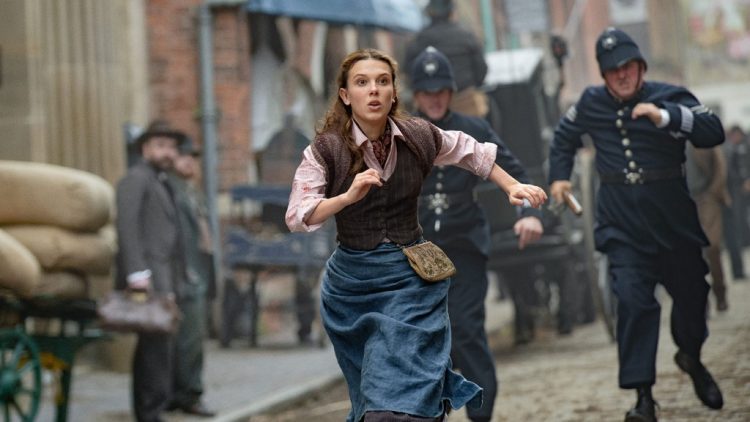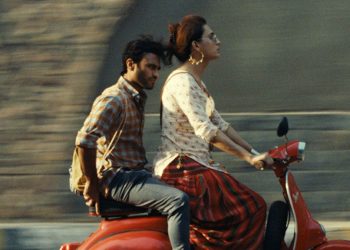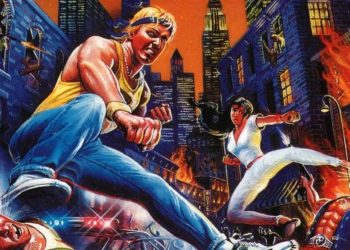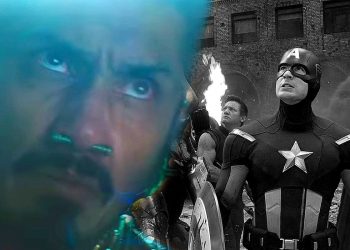There were a number of reasons the employees at the Bryant & May match factory wanted to strike in 1888: They were fined for trivial offenses, berated for small errors and paid abysmally for hours of grueling labor. But above all, their owners were killing them. A change in production methods — switching from red phosphorus to white — increased the company’s profit and poisoned the match factory employees. The women and girls developed phosphorus necrosis, a disease that caused engorged abscesses in the mouth and fatal brain damage.
Enola Holmes, the protagonist of the quick-witted and fanciful eponymous YA book series, doesn’t know all of this when she agrees to a missing person case at the beginning of Netflix’s Enola Holmes 2. Our young detective (played by the exceptional Millie Bobby Brown) is just itching to solve a mystery. Her attempts to start her own practice — economically chronicled in the buoyantly edited opening sequence — are thwarted by ageism (“Well,” one patron says warily, “you’re young”), sexism (“Am I addressing the secretary?”) and the popularity of Sherlock Holmes (“Tell me, might your brother be free?”).
Enola Holmes 2
The Bottom Line
One too many loose threads.
When Bess (Serrana Su-Ling Bliss) wanders into Enola’s office, the dejected investigator is at once surprised and psyched. The search for Sarah, a missing match factory worker, vaults Enola into the thick of a brewing labor fight and sends her through the maze of London’s working-class politics. Similar to its popular predecessor, Enola Holmes 2 anchors its protagonist in the real-life sociopolitical battles of her time — an approach that heightens the stakes of her cases and invites viewers to flex their own detective skills. But as the second installment in what is now comfortably a franchise, Enola Holmes 2 must also build a sturdy foundation for more of its main character’s adventures.
This additional responsibility weighs on the film, which struggles to maneuver its excess baggage. Enola isn’t only preoccupied by Sarah’s disappearance; she is also navigating burgeoning feelings for Lord Tewkesbury (Louis Partridge) and trying to escape her brother Sherlock’s (Henry Cavill) shadow and condescending interventions. Sherlock, who became Enola’s legal guardian at the end of the first film, must now balance his own work with his fraternal duties. While Enola Holmes 2 is dedicated to our determined heroine’s perspective, it occasionally entertains Sherlock’s point of view — shifts that awkwardly bifurcate the film’s focus and create one too many loose ends.
If we are to take Eudoria’s (a delightful Helena Bonham Carter) advice to Enola about detective work seriously — the profession’s only rule is to “pull on every loose thread” — then, while these wayward filaments don’t unravel the garment, they do become unnecessary distractions. And the understandable urge to snip and tidy them before the credits roll translates to a film dogged by uneven pacing.
Enola Holmes 2 initially moves with a steady hum as Enola follows Bess into a different part of London. The cobble-stoned streets and stately Victorian-style buildings are replaced by muddied roads and smoggy factories. Enola goes undercover as a match factory girl and collects early clues — a strand of hair, a burned note and discarded letters — that help her write the narrative of Sarah’s disappearance. The pieces come together with satisfying ease until Enola realizes that her case is much bigger than a missing person one; it’s about corruption, corporate greed, fraud and an underground labor movement.
With the increased stakes, Enola begrudgingly seeks Sherlock’s advice. Their loving but tense sibling dynamic is one of the most interesting parts of Enola Holmes 2: Brown and Cavill have a delightful on-screen dynamic that believably replicates the caustic communication style typical between older and younger siblings. The two don’t know how to connect and often end up misunderstanding or talking past each other, and it’s in those moments that we see Enola and Sherlock’s characters develop the most.
As the siblings’ paths cross with more frequency, Enola Holmes 2 swings and swerves in directions that interrupt the steady pacing. The whimsical meanderings only lengthen the film and, unfortunately, fuel our impatience for the end. Harry Bradbeer is back as director, deploying a slate of similar techniques — breaking the fourth wall, dynamic perspective shifts, the occasional expository animated sequence, scenes reveling in Enola’s jiu jitsu skills. There’s also meticulous production and costume design by Michael Carlin and Consolata Boyle, which transport viewers to 19th century London and highlight the city’s growing economic inequality and contradictions. But even these touches don’t distract from the draggiest segments of the film.
Bradbeer conceived of the story, based on the books by Nancy Springer, with returning screenwriter Jack Thorne. The narrative flexes its signature wit — Enola is still sharp-tongued and prone to ill-timed bursts of honesty — but takes on more than it can reasonably unpack. The 1888 match girl strike, which was a process of community building, a focused effort on we, gets repackaged as a lesson in one voice leading the masses. That’s somewhat to be expected in commercial narrative efforts, but it doesn’t make it any less frustrating. Enola Holmes 2‘s shortcomings don’t wreck the film — it’s a serviceable sequel — but the tension between the topics the film tackles and the soft-pedaled approach is one that hopefully won’t haunt future projects.
Full credits
Distributor: Netflix
Production companies: Legendary Entertainment, PCMA Productions
Cast: Millie Bobby Brown, Henry Cavill, David Thewlis, Louis Partridge, Susan Wokoma, Adeel Akhtar, Sharon Duncan-Brewster, and Helena Bonham Carter
Director: Harry Bradbeer
Screenwriters: Jack Thorne (story and screenplay by), Harry Bradbeer (story by), Nancy Springer (based on the story by)
Producers: Mary Parent, Alex Garcia, Ali Mendes, Millie Bobby Brown, Robert Brown
Executive producers: Joshua Grode, Michael Dreyer, Paige Brown, Jane Houston, Harry Bradbeer, Jack Thorne
Director of photography: Giles Nuttgens, BSC
Production designer: Michael Carlin
Costume designer: Consolata Boyle
Editor: Adam Bosman
Composer: Daniel Pemberton
Casting director: Orla Maxwell, CDG
Rated PG-13,
2 hours 10 minutes
THR Newsletters
Sign up for THR news straight to your inbox every day
Sign Up
Source by www.hollywoodreporter.com











